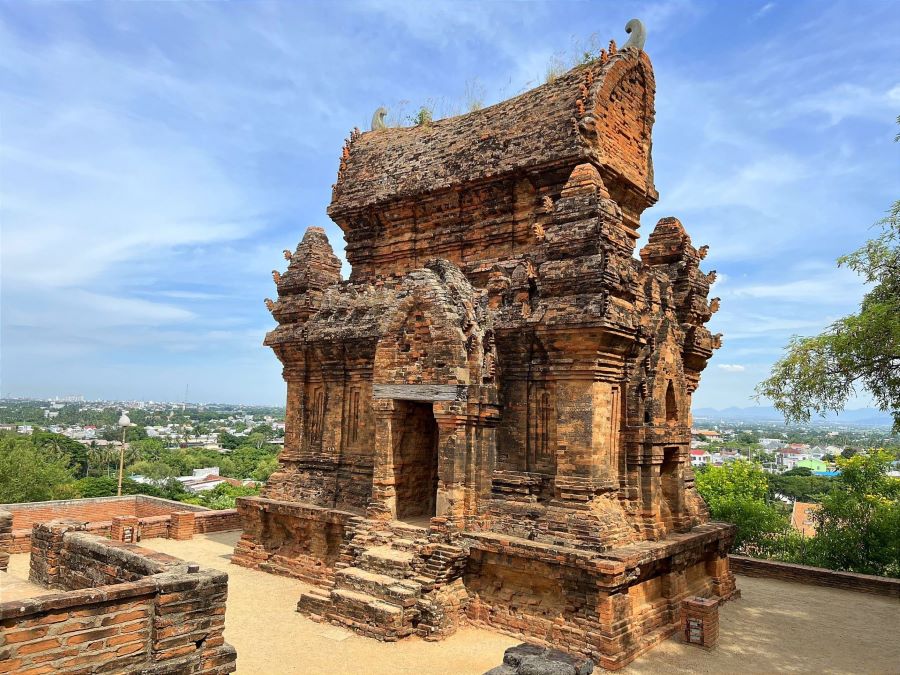Tet Holiday – Traditional Dishes and Customs of the Vietnamese
Travel to Vietnam, people in this country have a lot of very important festivals every year. They organize parties to keep the memory of the heroes or to celebrate the special occasions of the country. If you want to admire the unique beauty of this country and discover precisely the customs and culture of the Vietnamese people, Tet holiday is a better choice for you on your trip to Vietnam.
The Vietnamese Lunar New Year celebration is otherwise known by the name “Tet”. This is a special occasion in Vietnam. It is a riot of colors, an explosion of firecrackers, the districts compete in ingenuity to be the best in their dances and decorations. During this special and meaningful occasion, the Vietnamese spend time not only for the family but also for the ornament of the house and the unique gastronomy. Here are the traditional dishes and interesting customs to discover.
Lunar Tet Holiday Calendar
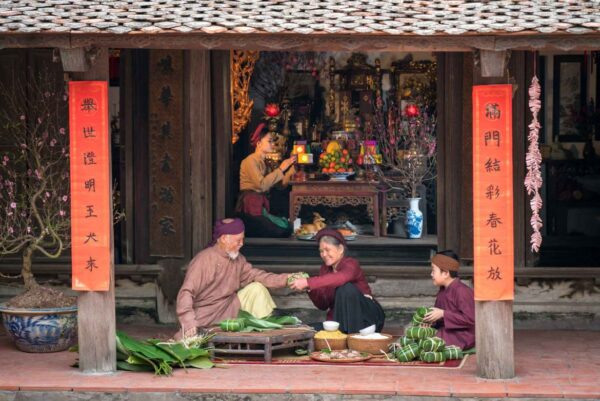
Lunar New Year – Vietnamese Tet
The holiday falls between January and February of the Western calendar: its date changes each year due to the difference between the solar and lunar calendars. The first three days are the most important. The country’s activity is thus reduced to a minimum. You can learn about the special Vietnamese culture and customs. Here is the Lunar Tet Holiday Calendar:
- 2025: January 29
- 2026: February 17
- 2027: February 6
- 2028: January 26
Traditional Dishes During Tet Holiday
Vietnamese gastronomy is very unique and delicious. Each dish is a perfect combination of ingredients and the meticulousness of the cooks. In particular, this thing is rendered precisely in the traditional dishes of Tet in Vietnam.
Therefore, there are so many delicious dishes not to be missed during Vietnam’s biggest festival, Tet! There are also various versions of dishes among the different regions. The only way to enjoy them is to book a trip and come enjoy as much as possible. When you savor the food, the real Vietnamese culture will reach you.
A hearty meal in the North of Vietnam
Northerners often prefer form. Therefore, on New Year’s Eve meals, the dishes are beautifully and meticulously garnished. According to the traditional concept, there are 6 plates or 8 bowls of 8 dishes that represents fortune in a tray. For several years, Northern people have kept all the customs of the country. In particular, it should include traditional dishes such as:
1. Chung cake (Banh chung)
This is the Vietnamese typical dish on the Lunar New Year with its ingredients of glutinous sticky rice, mung beans, pork and other elements. Lang Lieu, a prince of the last King of the 6th Hung dynasty, was said to create Banh chung and Banh giay that symbolized the earth and the sky.
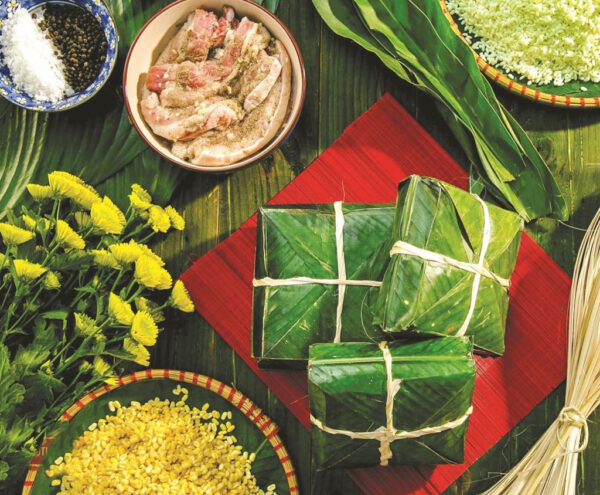
Chung Cake is a Vietnamese Traditional Sticky Rice Cake
This square rice cake has its creation process with all the component parts wrapped in phrynium placentarium (a leaf resembling that of a banana tree) and tied with bamboo twigs, that gives it the appearance of a gift. Not only on Tet holiday, Chung cake is also served all year round as Vietnamese cuisine. Hence, you can try this dish anytime on your trip to Northern Vietnam.
2. Gac fruit sticky rice (Xoi gac)
The Vietnamese have the concept that red is a lucky color of blessing that symbolizes love and happiness. Gac’s red color is also the natural color of earth and sky, bringing harmony and harmony. That’s the reason why the food is widely preferred by all of the Vietnamese on any occasion, especially on Lunar holidays. This sticky rice is usually served with white cut chicken.
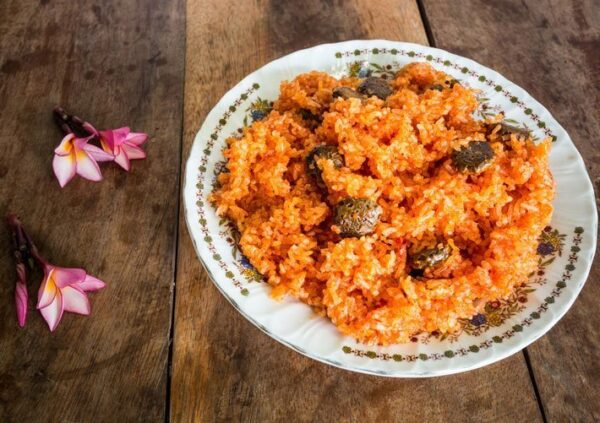
Xoi Gac
3. Vietnamese head cheese (Gio thu)
Originating from the North of Vietnam and now popular throughout the country, the form of processing is more or less similar to this dish also exists in many other cuisines in the world. The processing is relatively easy, the ingredients are easy to find, the finished product is delicious and slightly crunchy, making it a familiar dish of people throughout the region. The sausage is usually made by families during the traditional Tet holiday, and are sold at spring rolls shops in most markets nationwide.
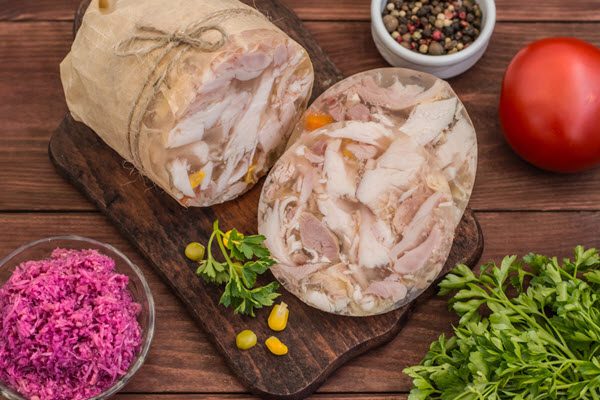
Gio Vietnam
This dish is mainly made with pieces of pork head (tongues, ears, snout) which is flavored with onions and garlic, black mushrooms, pure fish sauce and pepper. You can enjoy the best of this dishes with hot white rice, pickled vegetables and pure fish sauce with pepper.
4. White cut chicken (Ga luoc)
This is another popular Tet party dish that is easy to make and juicy to taste. White cut chicken is essentially whole chicken cooked in a pale yellow color. This indispensable dish should not be eaten before being placed on the altar to pay homage to the ancestors.
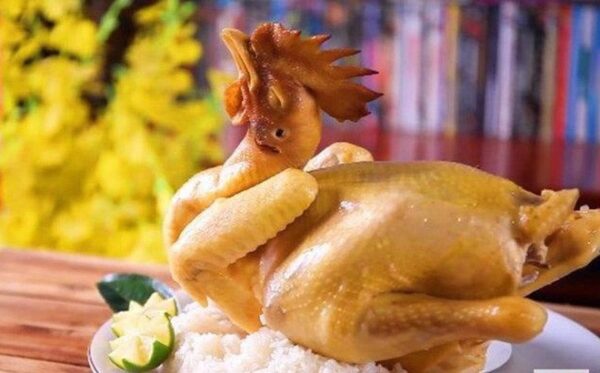
White cut chicken
Then, the boiled chicken is cut into small parts, like a turkey in the west. Because Vietnamese people often simply boil chicken with only water, it is often served with a small dish of salt, finely sliced lime leaves, lime juice and a little sliced chili.
5. Vietnamese fried spring rolls (Nem)
This is certainly one of the best-known dishes of Vietnamese cuisine abroad. This fragrant fried roll of caramel color, crunchy pancake and garnish made with minced pork, vegetables and spices is undoubtedly a must-try food once you visit Vietnam!
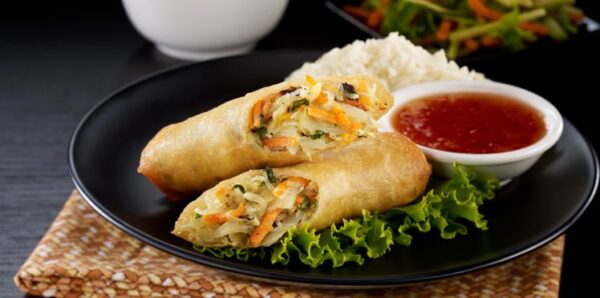
Nem Vietnam
It is a dish that wins the tables on special occasions, especially during the traditional Vietnamese festivals: Lunar New Year, weddings and birthdays. In a Vietnamese family, when the mother announces the Nem on the menu, all the members have a heart that pulsates and willingly lends a hand to make them!
6. Pickled vegetables/ onions
If you are looking for a typical flavor that goes well with Chung cake, Gac fruit sticky rice or Nem, etc. pickles is the ideal choice. Pickled sauerkraut/ onions is a popular and familiar dish in Vietnam made with the main ingredient of vegetables/ onions.
This is a side dish, a relief for too many greasy dishes. Pickles often stimulate the taste (due to the sour taste), so it creates appetite. Also, you can make this dish with kohlrabi or carrot.
7. Frozen pork
This is a traditional dish especially on New Year. To make this specialty, the cook sauté pork leg, pork ears (or pork skin) for meat to hunt, then stir fry with cloud ear fungus and mushrooms.
When the ingredients are quickly stirred to infuse the spices, pour the water into the pot so that the meat surface. Bring the water to a boil, turn down the heat, reduce the foam, so that the resulting meat is clear and not cloudy. Note, if this dish has the season of salt, it will not taste like frozen meat.
Unique dishes in the Central of Vietnam
1. Banh tet
The meaning of this dish is the convergence of the earth and the sky. It is a traditional dish not to be missed in the Center’s meal tray. Unlike Banh Chung wrapped in phrynium placentarium, Banh Tet is wrapped with banana leaves. The ingredients for this dish are similar to those in Banh Trung such as pork, pepper, green beans. On the other hand, the shape of this dish is a cylindrical hit. In traditional Tet meals of the Central inhabitants, it is essential to have a Banh tet dish.
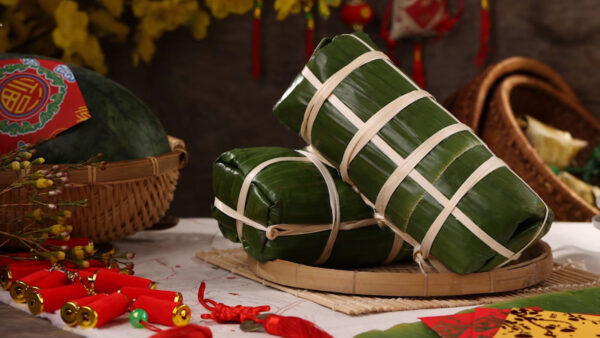
Banh Tet
2. Cured fermented beef (Nem chua)
It is a very famous dish in Central Vietnam. You can eat nem chua and drink a glass of beer to enjoy the best taste of this dish on Tet holiday.
Nem chua in Central Vietnam is made with pork, beef and marinated with spices, and wrapped in guava leaves or intestine leaves and then fermented. When tasting nem chua, you will feel the sweet, sour and crunchy taste that you will never forget on your trip to Central Vietnam.
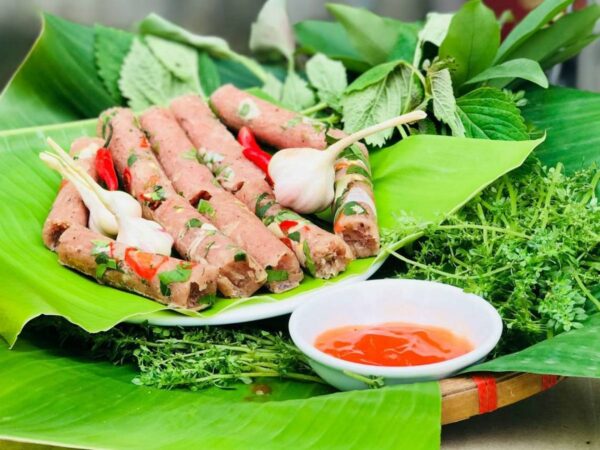
Nem Chua
3. Sour shrimp
This is the usual dish of people in Central Vietnam during Tet. Sour shrimp is also a specialty of the citadel Hue. Sour shrimp is the amazing combination of sticky rice, bamboo shoots, galangal, red shrimp, chili and all kinds of flavors: sweet, fatty, fleshy, spicy, sour, bitter, etc. It is also a combination of yin and yang, the coolness of shrimp mixed in the hotness of spice that is all very harmonious and charming. You can enjoy sour shrimp with hot rice. The most famous and delicious dish is the sour shrimp served with boiled meat, rice paper and melon and other raw vegetables.
The sour taste of shrimp, the pungency of spices has created an unforgettable impression for diners. So, if you set foot in Hue, you should buy this delicious dish as a gift, surely this will be a meaningful gift after the trip.
4. Vietnamese meatloaf (Gio)
This is generally served with Xoi (sticky rice) and Chung cake. The Vietnamese make Gio from lean meat, fish sauce and the wrapping of leaves, then boiling it for hours. Then, you can preserve Gio up to a month thanks to its covers. There are many types of Gio depending on their main ingredient: Gio lua (based on pork), Gio ga (based on chicken) and Gio bo (based on beef). All these types are used not only during Tet but also throughout the year.
5. Streamed meat with fish sauce
This dish is made from beef or pork, previously soaked in fish sauce in certain proportions. It is served with sweet and sour pickles and herbs to help combat boredom. This is one of the most traditional dishes in the tray of locals in the South during Vietnam Lunar Tet holiday, which is so easy to make.
6. Vietnamese caramel pork
During Tet in South Vietnam, this is a traditional dish not to be missed. Vietnamese caramel pork is known by another Vietnamese name “Thit kho trung”. Every family in the South has a jar of caramel pork on New Year’s Eve.
The pork has only three layers of lean and the fat is filled with eggs, coconut milk with a pretty brown color, beautiful. It can be eaten with pickles or banh tet. It’s very delicious.
Cozy food in southern Vietnam
1. Pickled onions and dried shrimp
Unlike the inhabitants of the center, people from the South do not eat onions marinated with Banh Tet on Tet holiday. They taste them with the dried shrimp. The sweet and sour onions are served with dried shrimp and sprinkled on a dish with a little sugar to enjoy the crisp, mellow taste.
2. Banh Tet
This dish has 2 types: sweet and savory. In particular, salted fillet Banh Tet based on traditional meat fat, green beans, sticky rice also contains sausages and salted eggs. Southwestern Banh Tet is nicely packaged so that you can buy this specialty home as a souvenir on your trip to Southern Vietnam.
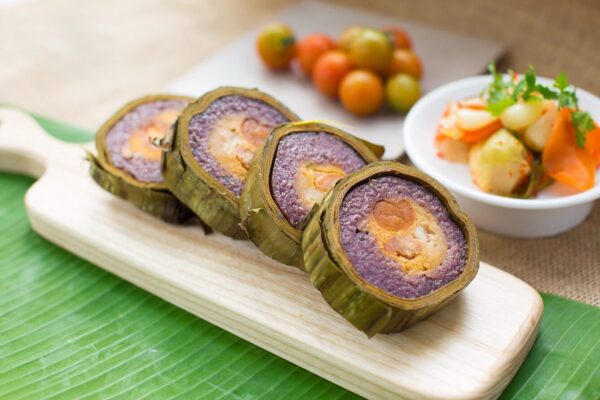
Banh Tet
3. Stuffed bitter zucchini soup
Bitter zucchini (kho qua) is a very popular vegetable during the Vietnamese Tet festival in the South. “Kho qua” means “the end of suffering” in Vietnamese. This is why we believe that if we eat bitter zucchini soup in the New Year, all suffering will pass.
This dish is good for health because bitter zucchini helps to cool the body, purifies the blood, eliminates pimples and plays an important role in the prevention and treatment of diabetes.
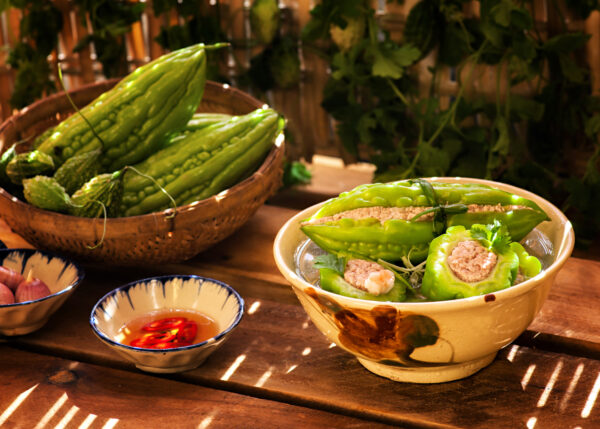
Stuffed bitter zucchini soup
4. Bean sprout sauerkraut
You can eat this with the famous New Year’s Banh Tet and caramel pork. The pickles of mung bean sprouts have a simple preparation without any other tricks than with the green of the leek and ginger. And the variety of colors was well-respected.
5. Chinese sausages (Lap Xuong)
The traditional dish for Tet holiday of people in Southern Vietnam is Lap Xuong. On the occasion of Tet, people buy a lot of Chinese sausages alongside other dishes. You can choose from many types of sausages among shrimp, fish, and dry sausage. You can cook sausages in several ways, such as frying, baking, and steaming.
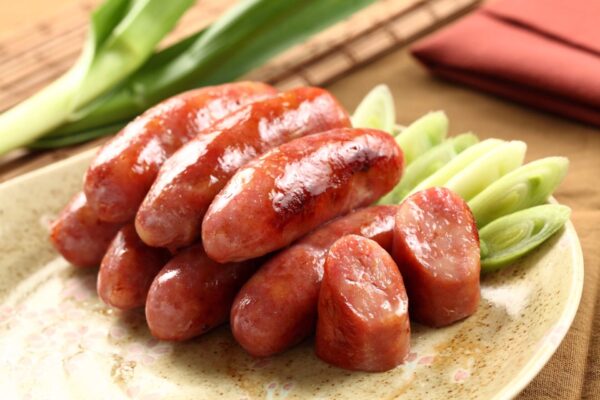
Lap Xuong
Traditional Customs of the Vietnamese During Tet Holiday
The Vietnamese have a lot of unique customs. That is also a characteristic symbol of the culture of this country. Here comes some very interesting information about these customs.
Visiting the cemetery
During the week leading up to Tet, a visit to the cemetery is a cannot-be-missed activity to invite the spirits of dead relatives to participate in the celebrations. This is also a chance for relatives who work or live far from home to gather. The ties are tightening to allow the new year to start on a new basis, the debts are paid and everything is cleaned or repainted.
“Ong Cong Ong Tao” worshiping day
Preparations begin seven days before New Year’s Eve (the 23rd day of the 12th lunar month) when the Tao Quan – the three spirits of the hearth of each house – ascend to heaven and report the events of the year to the Jade Emperor. These household gods are sometimes described under the name – Ong Cong Ong Tao.
On Tet holiday, especially this day, the ancestral altar is loaded with offerings and food, a little alcohol, flowers, betel nuts, and paper travel costumes and paper money and the three small live goldfish.
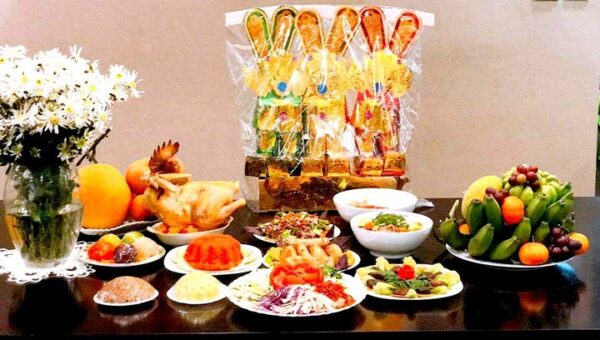
“Ong Cong Ong Tao” worshiping day
The day when the Tao Quan goes up to the sky, they ride fish. Therefore, you can observe throughout the country the Vietnamese dropping three small goldfish in the rivers or lakes. The paper costumes and money will then be burned so that the smoke reaches the Genie. With this preparation, the Vietnamese hope to have a favorable relationship and thus attract luck for the coming year.
Home decoration
Like the Western Christmas tree tradition, Vietnamese homes are decorated with colorful trees on Lunar New Year. A Tet pole (Cay Neu) is erected to ward off evil spirits. The kumquat is widely preferred, but there are also other branches of peach blossoms (Hoa dao) in the North, branches of apricot (Ochna integerrima – Hoa May) in the Central and South.

Tet Holiday in Vietnam
Gallivanting the flower markets
These sites offer a superb spectacle. In Hanoi, you will see that Hang Luoc and Hang Ma streets turns into a real huge market for kumquats, peach blossoms and apricot. A very colorful market of pink, green, orange, yellow that attracts a lot of visitors these days.
In the days before New Year’s Eve, the excitement is almost palpable in the markets. People rush to buy decorations and food, motorcycles laden with kumquats and peach trees cluttering the streets.
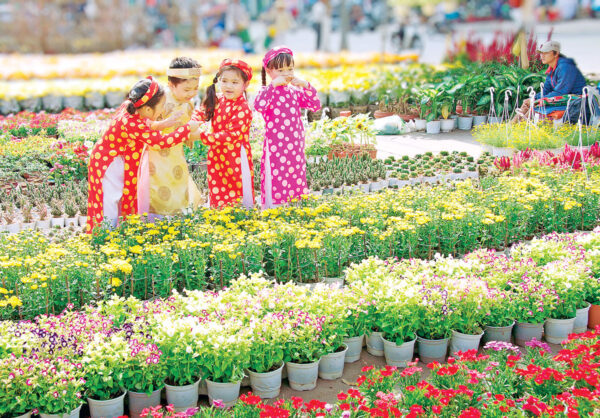
Flower markets in Vietnam
Five-fruit platter preparation
According to our belief, there are emblems of five elements of the cosmos, metal, wood, water, fire. Hence, the Vietnamese offer the respective wishes for Phuc, Loc, Tho, Khang, Ninh or Happiness, Prosperity, Longevity, Health, and Peace.
On Tet holiday, these offerings vary according to seasonal fruits and specialties from each region. As we have a wide range of choices today, the kinds of fruit chosen are more numerous, even up to ten. Grapes, pears, peppers, sapotes, bananas, etc. are also on display. Anyway, it is still called “Mam ngu qua” or a five-fruit platter.
- In the North, traditionally the typical 5 includes a diet of green bananas, grapefruit, peaches, persimmons, and tangerines. The bananas support other fruits of different colors such as green, orange, red, etc.
- In the Center, there are often bananas, dragon fruit, watermelon, soursop, oranges, mandarin, ficus racemosa, etc.
- In the South, the 5 shows the locals’ sense of humor and sobriety. The collection consists of fruits, namely soursop, coconut palm, banana, mango and pineapple which are very popular in this region. They are presented by their pronunciation of wishes for a justly sufficient life. It is a play on words, which means “ask for enough for the expenses.” It is customary for southerners to prepare offerings with other fruits such as pear, dragon fruit, pomegranate and watermelon.
In this great variety, it is not by chance that they are the fruits of choice, because each has its own meaning.
First-foot (Xong nha)
This is an indispensable custom in the traditional Tet. According to the original conception, the first visitor who enters the house will determine the luck or bad luck for the owner in the whole year. Usually, people will choose a person whose age is suitable for the zodiac sign of the owner’s age. Then, they ask him to visit the house.
“Luck” picking (Hai loc)
In the morning of the first day of the year, when we leave our house, we will break a small branch of a tree and that means the symbol of fortune and luck. However, nowadays, this custom is increasingly replaced by another activity that has the same meaning but respects nature better. We buy a pair of camellia amplexicaulis and place it next to the ancestral altar until the end of Tet.
Giving lucky money (li xi)
For a long time, red envelopes (New Year’s gifts) have been essential during the traditional Tet in Vietnam. A person offers the other a red envelope with money inside – this activity is “li xi”. This gift, specially reserved for children, symbolizes luck and health for the New Year. By offering lucky money in red envelopes to children, adults want them to grow up quickly and study well, while with the elderly, they wish them longevity.
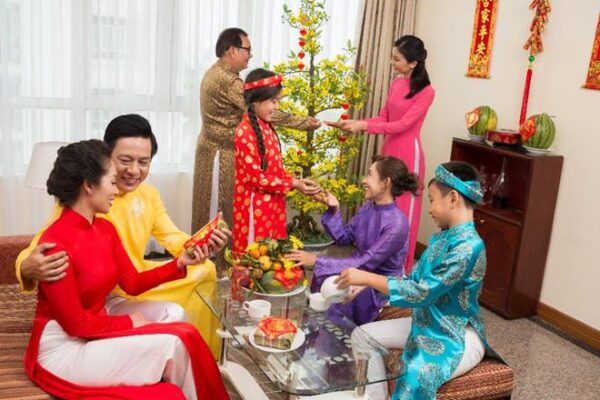
Giving Lucky Money – Tradition in Families During Tet in Vietnam
Buying salt
We always say that “buy salt at the beginning of the year and calcium oxide at the end of the year”, that is to say, we buy salt at the beginning of the year and lime at the end of the year.
In the preparation of Tet, in addition to cleaning the house, we will repaint the walls with calcium oxide, following the belief that spreading calcium oxide in four corners of the house can prevent ghosts and devils.
And why do we buy salt? Salt symbolizes warm feelings, harmony in the family and social relationships. That is the reason why it’s a custom that we cannot forget in those days.
Collecting calligraphy letters
This is a beautiful tradition that represents the respect of the Vietnamese for education. About ten days before Tet, this custom begins. The master will give you the calligraphy letter with a brush of characters “Happiness”, “Longevity”, “Genius”, etc. that present wishes or parallel sentences on red paper.
Read more: Calligraphy Vietnam: Essential custom of Tet

Tradition of giving calligraphy letters on Lunar New Year
Read more:
Start planning your tailor-made Vietnam tour by contacting one of our specialists…




